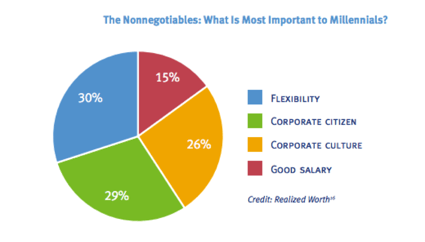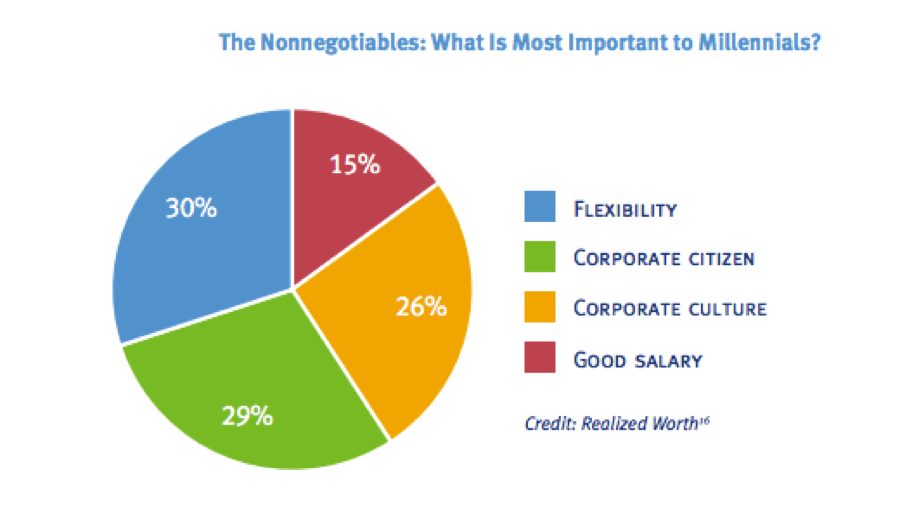 The Millennial Generation, a group of Americans born between the 80s and mid 2000s, is the largest population in US history, accounting for approximately one-third of the US population and roughly 50% of the US workforce. Characterized as the most social (75% have a social media profile), tech-saavy (use 2-3 tech devices daily), and educated (61% have a college education, compared to 46% of Baby Boomers) generation, the Millennial cohort has also proven to be a challenge for businesses as it relates to employee retention. In fact, According to a 2013 study conducted by consulting firm Millennial Branding, 30% of surveyed companies lost 15% or more of their millennial employees in the preceding year. And an astounding 78% of Millennials anticipate leaving their company within the next two years and 91% within the following three.
The Millennial Generation, a group of Americans born between the 80s and mid 2000s, is the largest population in US history, accounting for approximately one-third of the US population and roughly 50% of the US workforce. Characterized as the most social (75% have a social media profile), tech-saavy (use 2-3 tech devices daily), and educated (61% have a college education, compared to 46% of Baby Boomers) generation, the Millennial cohort has also proven to be a challenge for businesses as it relates to employee retention. In fact, According to a 2013 study conducted by consulting firm Millennial Branding, 30% of surveyed companies lost 15% or more of their millennial employees in the preceding year. And an astounding 78% of Millennials anticipate leaving their company within the next two years and 91% within the following three.
Why is this a problem?
- 87% of companies reported it costs between $15,000 and $25,000 to replace each Millennial employee they lose.
- It takes between 3 and 7 weeks to hire a fully productive millennial in a new role.
- 71% of companies reported that losing millennial employees increases the workload and stress of current employees.
- 51% of companies report the cost of training and development is the highest when hiring Millennials.
As it relates specifically to the call center space, an industry long associated with high employee turnover rates, close to 70% of the workforce is often comprised of Millennials. But according to a recent call center attrition study, agents ages 20-24 typically only work in the call center for an average of 1.1 years. So how can today’s businesses attract and more effectively retain tomorrow’s growing workforce to help ensure greater long-term success and employee stability?
4 Ways to help attract, engage, and retain your Millennial employees:
Create a flexible work environment: Millennials demand workplace flexibility. In fact, 89% say they would prefer to choose when and where they work rather than being a traditional nine-to-fiver and 45% value workplace flexibility more than pay. Thankfully, due to recent advancements in technology, notably cloud call center software and other SaaS solutions, contact centers can now grant their employees the ability to work from whichever location they choose, while maintaining the same, if not enhanced, levels of security and supervision.
Engage employees: Engagement and purposeful work have shown to double employee satisfaction—but it is something call centers have struggled with for years due to the relative monotony of the job. Many organizations, however, have successfully engaged their Millennial workforce through gamification, or the application of game mechanics and game design techniques in non-game contexts. By providing employees a real-time view of each other’s performance using various KPIs and metrics, contact centers can now more effectively enhance collaboration, create healthy competition, recognize and reward top performers, and motivate their workforce.
Offer competitive salaries: 69% of Millennials rank financial reward as the most important aspect of any job offer. But justifying salary increases or bonuses can be a challenge without cutting costs elsewhere within the organization. However, by deploying a contact center in the cloud, today’s average business can spend approximately 27% less on their annual costs and use the financial flexibility to compete for the best talent. It’s a win-win.
Take advantage of the latest technologies: Millennials want to work for organizations that foster innovation and utilize the latest in technology. In fact, 78% of Millennials are strongly influenced by how innovative a company is when deciding if they want to work there. As a result, call centers utilizing the most integrated solutions and platforms available, including WFM, WFO, CRM, and multichannel communications, are likely to see a happier and more loyal workforce. It will also help to eliminate cumbersome and manual processes while enhancing the organization’s overall effectiveness.





